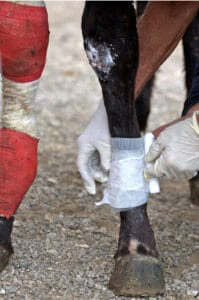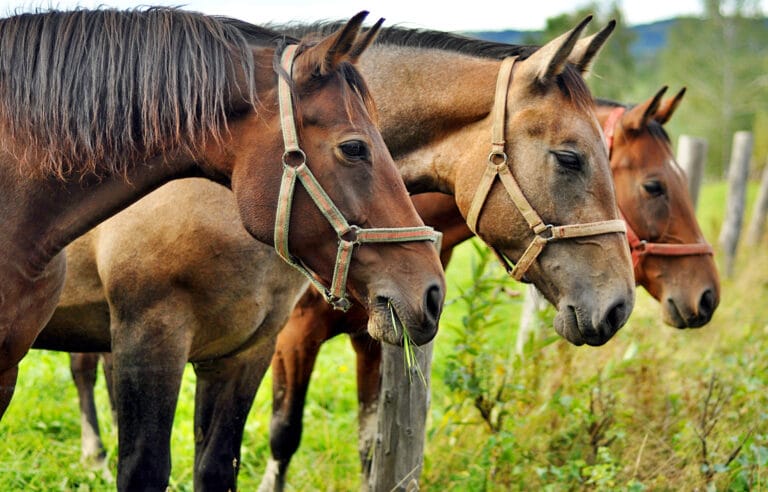They’re at the fence looking fine, until you spot that nasty looking wound. DR DOUG ENGLISH explains what to do next.
Horses can be prone to hurting themselves. No matter how vigilant we are, we cannot entirely safeguard them from cuts and abrasions either from an altercation with a paddock mate, or as the result of a lost fight with a wire fence.
The first thing that happens after a wound occurs is bleeding, which helps to clean the wound naturally but can be severe before blood clotting is activated. Pressure bandages with a pad are useful to help clotting, and coagulant improving substances such as clay or cornflower can be placed onto the wound.
Cleaning the wound
Wounds on horses are often discovered after the clotting processes have already occurred. But just like all wounds, they need to be cleaned and it is best to spray with normal saline in a spray bottle or garden spray. Normal saline can be easily made by adding table salt to water at a rate of nine grams per litre, or guess at one teaspoon to 500mls of water. Water from the hot tap is the best option because it will have been sterilised by being in the hot water tank. If you have no other alternative, then the second best option is to hose the wound with clean water.
All dirt needs to be removed, but if it has become hard and dry then bandage after applying an ointment such as natural honey, White Healer, Potties White, Hydrogel, BR Wound Powder, Solosite, Terramycin Powder, Betadine, F10, Dermaclens, or Filtabac.
Always apply a dressing to the wound and I prefer to use something bigger than the standard 7.5 centimetre dressing. Use a 10 to 15 centimetre wide bandage over cotton padding such as Combine Dressing, Gamgee, Pharwrap, or even plain cotton wool cut from a roll works well – but be sure to place a non-stick cover such as a Melolin low adherent dressing or a piece of paraffin gauze directly over the wound.

It’s important to keep wounds bandaged to maintain a moist environment and encourage healing.
The inflammation process
The next stage in the wound process is inflammation, and this stimulates healing. Anti-inflammatory medications will reduce this and should only be used for pain. They only suppress symptoms and do not cure, but they can have a positive effect by encouraging freer movement, which stimulates circulation and therefore healing.
If the wound has been correctly cleaned there should be little infection. However, if infection occurs, it is best controlled by topical preparations because, unless you’re dealing with a deep puncture, injected or oral antibiotics do not get to a significant concentration in the outer areas of a wound. Although it does no harm to give antibiotics initially, they are often used when not really necessary.
Keep the wound bandaged
The inflammation process stimulates the production of growth factors from nearby healthy tissue and also the migration of macrophages and neutrophils, which are cells that clean up dead tissue, attack bacteria and release further growth factors.
This process operates in a moist environment, not dry, and so it is important to keep the wound bandaged. Some people think, incorrectly, that drying out is best for wounds, possibly because a healthy wound will grow epithelial cells to cover the defect, and once that occurs effusion stops and the wound becomes dry.
But drying before this happens severely retards healing because epithelial cells will only migrate to cover the wound in a healthy, moist environment. The cells are also killed off by caustic compounds like bluestone (copper sulphate), which create scar tissue formed by fibroblasts.

With the appropriate care, Jock’s leg wound began to heal well.
Proud flesh
The formation of proud flesh is increased by granulocytes, a type of immune cell that has granules (small particles) with enzymes that release connective tissue-activating peptides, which cause fibroblast proliferation and the formation of a space-filling ground substance. This release can become excessive when wounds are slow to heal because of infection, irritation, premature drying, or an undetected foreign body.
The fibrobasts do contract eventually and pull the edges of the wound together. If healing stalls or the granulation tissue becomes excessive, it is best to get your vet to cut it off. If you use a caustic substance like copper sulphate it will remove the proud flesh but also causes healing delay, and replacement of the squamous skin cells with scar tissue that stays forever.
I like to use a sharp butcher’s knife to trim off proud flesh. It has no nerves and so does not cause pain, and cutting stimulates more inflammation which speeds healing. Lots of bleeding occurs however, but it resolves quickly and a pressure bandage should be applied. Most proud flesh is acceptable anyway – it does contract well and is minimised by protective bandaging.



